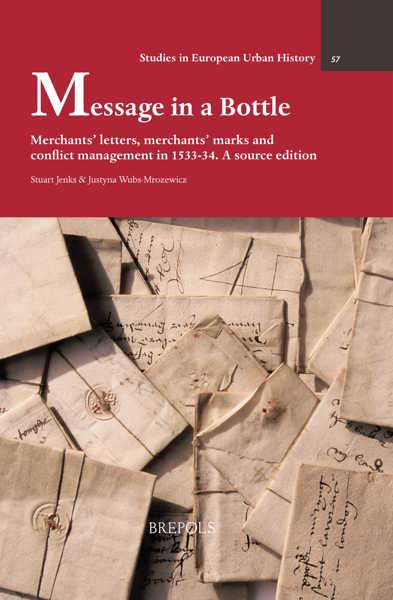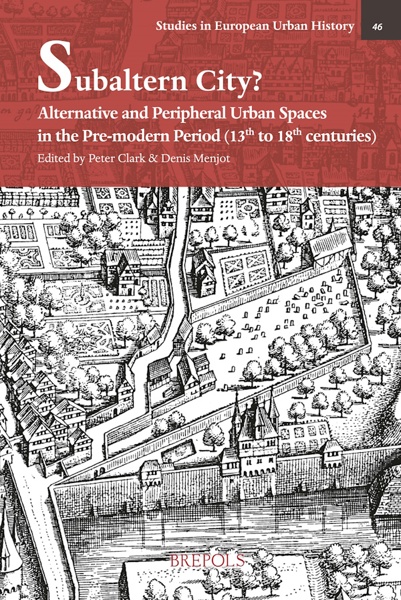
Urban Hierarchy
The Interaction between Towns and Cities in Europe in Late Medieval and Early Modern Times
Maria Asenjo González, Elisabeth Crouzet-Pavan, Andrea Zorzi (eds)
- Pages: 228 p.
- Size:178 x 254 mm
- Language(s):English, French
- Publication Year:2021
- € 81,00 EXCL. VAT RETAIL PRICE
- ISBN: 978-2-503-57727-2
- Hardback
- Available
- € 81,00 EXCL. VAT RETAIL PRICE
- ISBN: 978-2-503-57728-9
- E-book
- Available
“Urban Hierarchy contains ten contributions, which cover a time span from about 1200 to 1600, and concern investigations on urban structures. The volume is placed in an original investigative perspective: the hierarchical one (…) All in all, the results contained in the volume demonstrate the effectiveness of the “hierarchical” method.” (Beatrice Saletti, in The Medieval Review, 08/08/2022)
« Dans l’ensemble, l’ouvrage est une très belle contribution à la connaissance des réseaux urbains de la fin du Moyen Âge. » (Paulo Charruadas, dans le Moyen Âge, CXXIX, 2023, p. 1001)
María Asenjo-González: Her research focuses on urban history of Castile of Middle Ages, with special attention to the social and cultural questions: the urban territorial domination, the economic activities, the urban conflicts, taxation and the political participation in the building of the kingdom.
Élisabeth Crouzet-Pavan est une historienne médiéviste, spécialiste de l’histoire des derniers siècles du Moyen Âge, de l’histoire de l’Italie (âge communal, première Renaissance), des villes et des sociétés urbaines, tout particulièrement de Venise.
Andrea Zorzi: His research focuses on Italian political history of late Middle Ages, with special attention to Florence and Tuscany; justice organization in the period of the passage from communal rules to lordship; political conflicts in the Commune age; the building of territorial states and of their goernment rules; normative sources and statutes. He is also interested in methodology of historical research and new digital technologies.
Urban hierarchy means a new study approach that focuses on the reciprocal concurrence of relationships between urban centers, their complementarity, opposition, support and ongoing collaboration. The goal is to go beyond the single analysis of a city and focus on the interaction between towns and cities and to distinguish their dynamics and the degree of specialization within a political framework. The final objective is to provide a comprehensive historical analysis as urban history requires, open to the advantages of interdisciplinarity and the contributions of the international researchers that will take part in the book. The processes of urban hierarchisation are not only vital for observing the dynamics of cities, but also for studying in depth the response capabilities of the urban systems in the face of new challenges and stimuli. These aspects of the historical analysis of cities are still quite unexplored and, therefore, they will receive a great deal of attention in the book. The initial regional frameworks will not exclude small towns and rural centers since, even though they may look less potentially relevant, they might display greater specific development. Thanks to a renewed methodology and special attention to the empirical basis, it is possible to improve our knowledge of the urban systems of European regions at the end of the Middle Ages and the beginning of the Early Modern Era, shedding light on some aspects of the medieval past that will also influence other scientific areas of humanities.
Introduction
Urban Hierarchies in Pre-Modern Europe
Maria Asenjo-González
Part I - Urban Networks and Central Place
Rouen : pôle urbain et centre de consommation
Anne Kucab
Le réseau erfurtois à la fin du Moyen Âge. Une construction politique en marge du seigneur
Morwenna Coquelin
Urban Hierarchies in the Heart of the Po Valley (12th–15th century). Persistence and Change
Andrea Gamberini
Part II - Capital Cities and Political Actions
Rethinking Madrid during the Sixteenth Century. An Approach from Urban Hierarchies
David Alonso García
About the Urbanization in the Kingdom of Naples. The Campanian Area in 15th-16th Centuries
Francesco Senatore
Urban Networks ‘in Defence of the Realm’. Castilian Cities in Valladolid’s Orbit of Influence (1504–1520)
María Ángeles Martín Romera
Part III - Dynamics of Government. Cooperation, Rivalry and Conflict between Cities
The Town of Kolín and its Communication Horizons in the Late Middle Ages
Jan Vojtíšek
Urban Hierarchies and the Institutional Fabric of Late Medieval European Towns
Arie van Steensel
Resistance to Jurisdictional Predominance and Hierarchical Ambitions. Cadahalso versus Escalona (1232–1480)
Óscar López Gómez
The Interaction between the Bohemian Royal Towns and their Relation to the Cities of Central Europe in 1526–1620
Jana Vojtíšková




